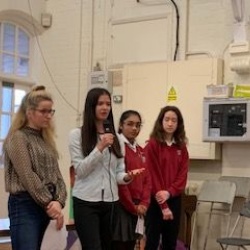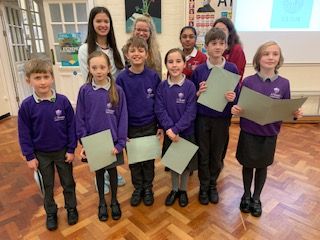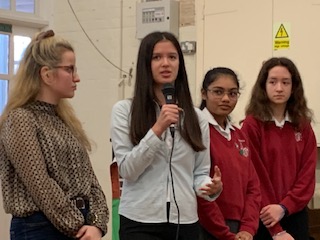Reading Council Climate Conference

On Monday 4 November, Emily, Anna Mae, Mia (Year 13s), Amy Grace and Rowena (Year 9s) were given the incredible opportunity to go to the Reading Council Climate Conference at Alfred Sutton Primary along with Ms Kattirtzi and Ms Fallows. There were lots of amazing presentations (and food!), which left us all inspired to do our part to help our planet.
The main guest speaker, David Edwards, gave an hour-long talk, jam-packed with information about how we know climate change exists, spanning from collecting samples from the bottom of the sea, to the study of bird vomit, penguins and polar bears. Covering topics including what news headlines say, he very clearly explained what is actually going on. For example, in the South Pole, the East is getting thicker because it is the top of the ocean freezing over and won't add any extra water when it melts - it's the West we need to worry about, as it is shrinking and will add extra water to the oceans, landing parts of the world underwater. Contrary to some beliefs, this is being caused by the “enhanced greenhouse effect”, not the “greenhouse effect”. The latter is very beneficial for the planet.
 For those of you who can vote (and even those of you who can’t), Mr Edwards said that every single member of the public can help bring the cause to attention - he pointed out that politicians are very conscious of doing things that will upset the public, as it will lose them votes - if we can all make an effort to let the government know how much we care, they are more likely to pick up on the fact that “we want change, and we want it now”, and include it in their campaigns (especially with the general election happening in a matter of weeks) to maintain and gain votes.
For those of you who can vote (and even those of you who can’t), Mr Edwards said that every single member of the public can help bring the cause to attention - he pointed out that politicians are very conscious of doing things that will upset the public, as it will lose them votes - if we can all make an effort to let the government know how much we care, they are more likely to pick up on the fact that “we want change, and we want it now”, and include it in their campaigns (especially with the general election happening in a matter of weeks) to maintain and gain votes.
After a short break (full of delicious cake!) a small army of smart eco warriors marched up to the front. The adorable eco club of All Saints Junior School! They presented a phenomenal talk, full of ambition, that left us nervous about our own!
We, along with Anna Mae and Mia, spoke about why climate change is important (the fact that  it’s regarded as a “climate crisis”) as well as what we are doing at Kendrick to raise awareness and do our part to help reverse the effects. At the end of our talk we answered some questions regarding our curriculum that challenged us to do some on the spot knowledge recall!
it’s regarded as a “climate crisis”) as well as what we are doing at Kendrick to raise awareness and do our part to help reverse the effects. At the end of our talk we answered some questions regarding our curriculum that challenged us to do some on the spot knowledge recall!
The last guest speaker was Melanie Hardwood, the creator of the UN's EduCCate courses for teachers, and more recently, students. She started off telling us her hilarious journey towards this incredible feat and then began a passionate speech on why every school across the country should have a “UN certified Climate Change teacher”. This concept sounds incredible and we can’t wait to see whether Kendrick teachers and students alike join in on the action.
There were also several stalls around the school hall including GreenPeace and Rushall Organic Farm. These had everything from booklets and posters to food and farm equipment!
On our way out we were each handed a “tree bomb” and some free posters to display around the school; eco-friendly reminders of a fantastic afternoon.
By Rowena (9L) and Amy Grace (9N)
